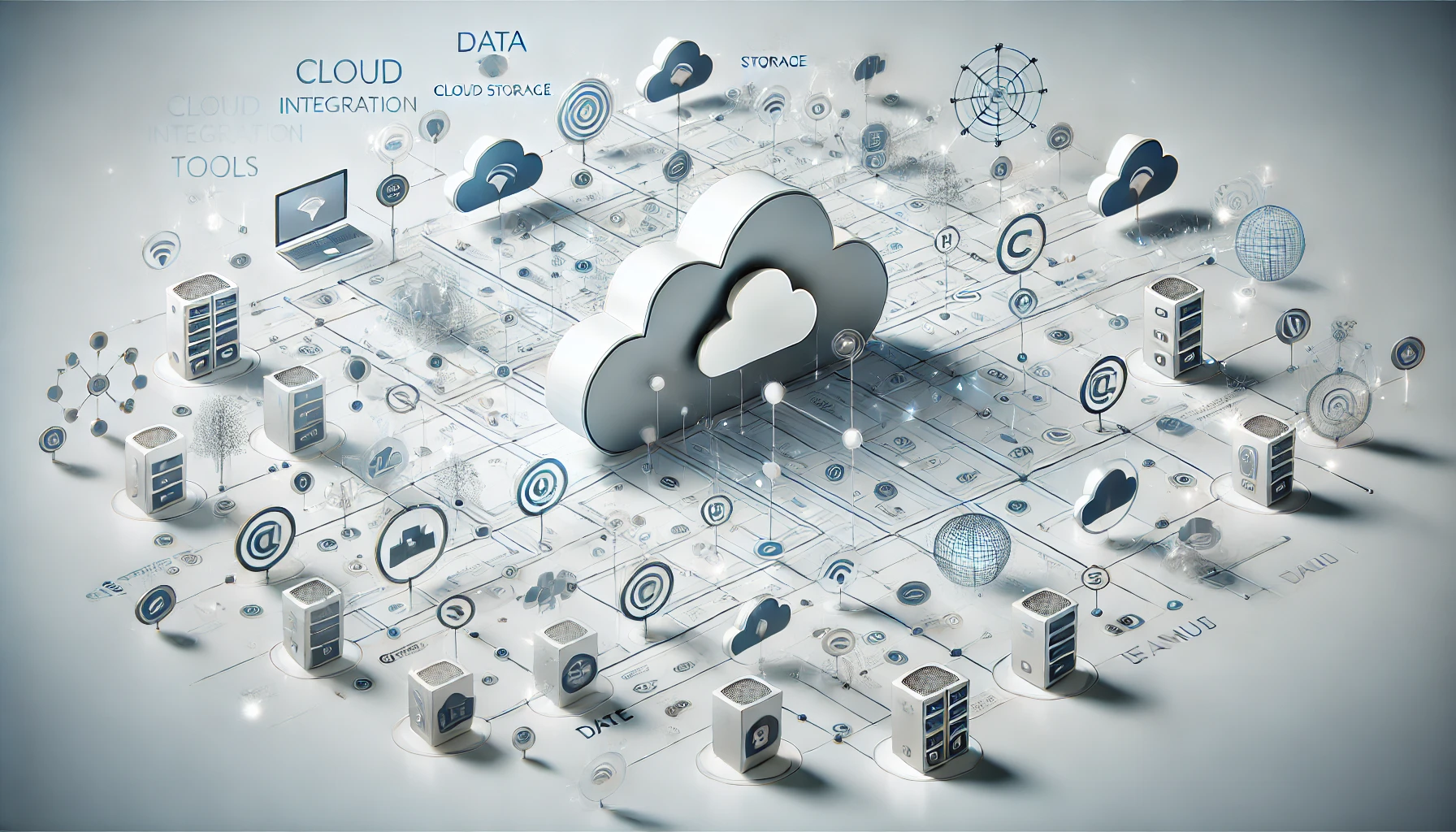As you contemplate the landscape of cloud integration services for the approaching year, envision a realm where iPaaS adoption, hybrid cloud integration, AI-powered solutions, enhanced security protocols, IoT connectivity, and microservices architecture converge to shape a future of seamless digital operations. The intricate dance between these trends promises to redefine the way organizations navigate the complexities of data integration and connectivity in the cloud. Stay tuned to discover how these evolving trends in cloud integration services will mold the digital ecosystem in 2025 and beyond.
Ipaas Adoption
Is your organization ready to streamline its cloud integration processes for 2025? Consider adopting Integration Platform as a Service (Ipaas) for cost-effective solutions and rapid deployment. Ipaas offers a centralized platform for connecting applications, data, and processes across cloud environments, on-premises systems, and hybrid infrastructure.
By leveraging Ipaas, your organization can reduce integration complexity and costs significantly. Ipaas solutions provide pre-built connectors, templates, and workflows that enable quick integration without the need for extensive custom coding. This accelerates the deployment of new integrations, allowing your business to adapt swiftly to changing requirements and market conditions.
Moreover, Ipaas offers scalability and flexibility, ensuring that your integration capabilities can grow alongside your business needs. With the ability to handle a wide range of integration scenarios, Ipaas empowers your organization to innovate and expand without being limited by traditional integration challenges.
Incorporating Ipaas into your cloud integration strategy can enhance agility, efficiency, and overall performance while driving digital transformation initiatives forward in 2022 and beyond.
Hybrid Cloud Integration
When considering Hybrid Cloud Integration, your focus should be on seamless data migration, ensuring that data flows effortlessly between on-premises and cloud environments. Scalability and flexibility are key aspects to prioritize, allowing your system to adapt to changing demands and workloads. Additionally, security and compliance measures play a crucial role in ensuring data protection and meeting regulatory requirements in a hybrid cloud setup.
Seamless Data Migration
Navigating the complexities of data migration in a hybrid cloud integration environment requires a strategic approach that prioritizes efficiency and accuracy. To achieve seamless data migration, a streamlined onboarding process is essential. This process ensures that data is transferred efficiently and securely between on-premises and cloud systems. By implementing a streamlined onboarding process, organizations can minimize downtime and disruptions during the migration phase.
Real-time synchronization is another key element for seamless data migration in hybrid cloud environments. This feature enables data to be synchronized instantly between different systems, ensuring that information is always up to date and consistent across all platforms. Real-time synchronization reduces the risk of data discrepancies and enhances overall data integrity during the migration process.
Scalability and Flexibility
Enhancing the scalability and flexibility of hybrid cloud integration is paramount for organizations aiming to adapt to evolving business needs and technological advancements. By leveraging elastic computing, companies can seamlessly adjust their computing resources based on demand fluctuations, ensuring optimal performance without over-provisioning. This dynamic resource allocation capability allows for efficient utilization of resources, reducing costs and enhancing overall operational efficiency.
Incorporating elastic computing into hybrid cloud integration enables organizations to scale resources up or down in real-time, responding to workload variations instantaneously. This agility ensures that applications run smoothly even during peak usage periods, maintaining a consistent user experience. Dynamic resource allocation further streamlines operations by automatically distributing workloads based on predefined policies, optimizing resource usage across the hybrid cloud environment.
Security and Compliance
To ensure the integrity and compliance of your hybrid cloud integration, robust security measures must be implemented seamlessly alongside your operational framework. Regulatory challenges and adherence to industry standards are crucial components in safeguarding your data in the cloud. With the evolving landscape of data protection laws and regulations, staying compliant requires a proactive approach to security.
Implementing encryption protocols, access controls, and regular security audits are essential to mitigate risks and maintain compliance with various regulatory requirements. By incorporating industry best practices such as multi-factor authentication and data encryption at rest and in transit, you can enhance the overall security posture of your hybrid cloud integration.
Furthermore, staying informed about emerging threats and vulnerabilities is key to proactively addressing security concerns. Regular training for staff on security protocols and procedures can help create a culture of security awareness within your organization. By prioritizing security and compliance in your hybrid cloud integration strategy, you can better protect your data and operations in the ever-evolving digital landscape.
AI-Powered Integration
With the rapid advancements in technology, AI-powered integration has emerged as a game-changer in the realm of cloud services. Leveraging machine learning and natural language understanding, AI-powered integration offers a seamless and intelligent way to connect various applications and systems. Here are five key aspects that highlight the significance of AI-powered integration:
- Automated Data Mapping: AI algorithms can automatically map data fields between different systems, saving time and reducing manual errors.
- Predictive Insights: By analyzing data patterns, AI can provide predictive insights into potential issues or opportunities for optimization.
- Real-time Data Processing: AI enables real-time processing of data streams, ensuring up-to-date information across integrated systems.
- Enhanced Efficiency: AI-powered integration streamlines workflows, automates repetitive tasks, and enhances overall operational efficiency.
- Adaptive Integration: AI can adapt to changing data formats and structures, making integration flexible and scalable for evolving business needs.
Embracing AI-powered integration can revolutionize how organizations connect and utilize their cloud services, driving innovation and competitiveness in the digital landscape.
Increased Security Measures
As you explore the realm of cloud integration services for 2025, the focus on increased security measures becomes paramount. Enhanced data encryption and the implementation of multi-factor authentication are key points to consider. These measures are crucial in ensuring the protection of sensitive information and safeguarding against cyber threats in the ever-evolving digital landscape.
Enhanced Data Encryption
Implementing enhanced data encryption is crucial in ensuring the security and integrity of your cloud integration services for 2022. Safeguarding your data privacy through robust encryption techniques is paramount in today’s digital landscape. Here are five key points to consider:
- End-to-End Encryption: Secure data transmission from source to destination.
- Zero-Knowledge Encryption: Service providers have no access to your decryption keys.
- Homomorphic Encryption: Perform operations on encrypted data without decryption.
- Quantum Encryption: Next-gen encryption to protect against quantum threats.
- Transparent Data Encryption: Protect data at rest within the cloud environment.
Multi-factor Authentication
To fortify the security of your cloud integration services for 2025, consider bolstering your defenses with Multi-factor Authentication (MFA) as an integral part of your increased security measures. Multi-factor Authentication enhances security by requiring users to provide two or more forms of identity verification before granting access. By combining something the user knows (like a password) with something they have (like a fingerprint or a security token), MFA significantly reduces the risk of unauthorized access to your systems.
When implementing Multi-factor Authentication, it’s crucial to explore various authentication methods such as biometrics, SMS codes, or authenticator apps. Each method adds an extra layer of security to your cloud integration services, making it harder for malicious actors to compromise sensitive data. By incorporating MFA into your security strategy, you can ensure that only authorized users with valid credentials can access your systems, mitigating the risks associated with password theft or brute force attacks. Stay ahead of cyber threats in 2022 by adopting Multi-factor Authentication as a fundamental security measure.
IoT Integration
You can seamlessly connect your Internet of Things (IoT) devices to your cloud infrastructure using modern cloud integration services. IoT integration is crucial for unlocking the full potential of your smart devices and leveraging connectivity solutions efficiently. Here are five key points to consider:
- Scalability: Easily scale your IoT ecosystem with cloud integration to accommodate growing device fleets.
- Real-time Data Processing: Process data from smart devices in real-time, enabling quick decision-making based on live insights.
- Security Measures: Implement robust security protocols to safeguard IoT data transmitted between devices and the cloud.
- Interoperability: Ensure seamless communication between different types of IoT devices and cloud platforms for enhanced functionality.
- Edge Computing Integration: Combine cloud services with edge computing to optimize data processing and reduce latency for IoT applications.
Microservices Architecture
Embracing a modular approach to software development, Microservices Architecture breaks down applications into smaller, independently deployable services that work together seamlessly. This architecture enables you to scale and update specific parts of your application without affecting the entire system. Container orchestration tools like Kubernetes have become essential for managing these microservices efficiently. They automate the deployment, scaling, and monitoring of containers, ensuring your system runs smoothly.
Moreover, implementing a service mesh within your Microservices Architecture can enhance communication between services. Service mesh tools like Istio provide capabilities such as load balancing, encryption, and traffic management, improving the resilience and security of your microservices. By offloading these functionalities to the service mesh layer, you can simplify the development and maintenance of your microservices. Overall, adopting Microservices Architecture with container orchestration and service mesh integration can streamline your software development process and enhance the performance of your applications.
Frequently Asked Questions
How Can Businesses Ensure Data Privacy in Cloud Integration Services?
To ensure data privacy in cloud integration services, you must adhere to compliance requirements. Implement robust encryption methods to safeguard sensitive information. Stay ahead by continuously updating security measures to protect your data from potential threats and breaches.
What Are the Key Challenges in Implementing Iot Integration?
To implement IoT integration, businesses must tackle IoT scalability challenges and data interoperability issues. Addressing device connectivity, data formats, and system integration will be crucial. Ensure a robust infrastructure to handle the complexities of IoT ecosystems efficiently.
Are There Any Potential Risks Associated With Microservices Architecture?
Scaling microservices can pose challenges, but proper design mitigates risks. Addressing scalability concerns through strategic planning and load balancing is crucial. Performance trade-offs may occur, yet optimizing service interactions and communication can enhance overall system efficiency.
How Does AI Improve the Efficiency of Cloud Integration Services?
AI driven optimization enhances cloud integration services by automating repetitive tasks, improving data accuracy, and predicting potential issues. This leads to increased efficiency, reduced manual intervention, and streamlined workflows, ultimately optimizing system performance and user experience.
What Are the Best Practices for Securing Hybrid Cloud Integrations?
When securing hybrid cloud integrations, remember to safeguard data like guarding a precious treasure. Implement robust identity management to control access and sturdy encryption protocols to lock information securely. Your vigilance is key.


